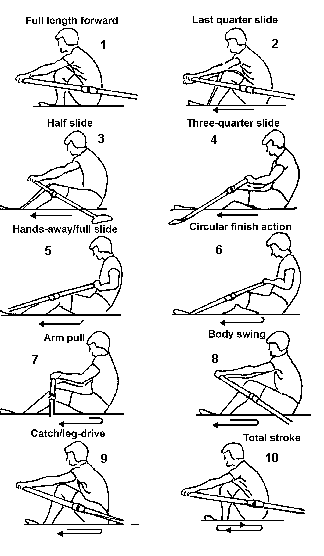
A BACKWARD SHAPING PROGRESSION - ROWING
[Rushall, B. S. (1984). Applied rowing research report III: A sequential approach to teaching rowing technique - backward shaping. Research report, Wintario, Ministry of Tourism and Recreation, Government of Ontario.
Reprinted in Coaching Notes CARA, October, 1984. Part I Motor learning and teaching methods.

The diagram below illustrates the sequence of instructional progressions for learning to execute a sweep-oar rowing stroke. The sequence breaks with tradition by defining the end of the stroke as the last position attained prior to executing the "catch." Consequently, the progression requires instruction to first focus on what is done out of the water ("the recovery") before any in-water activities are attempted. An added benefit to this sequence is that the beginner first knows how to prepare to do work in the water and how to extract the oar at the finish. That eventually frees the individual to concentrate on the movements that are important for producing propulsive forces.
The concept of the end of the stroke being the last preparation prior to affecting a catch, focuses attention on correct preparation, something which is very difficult to instruct in traditional teaching progressions. In accordance with correct pedagogical principles, each trial must be completed successfully by attaining the desired terminal position.

Return to Table of Contents for this issue.
